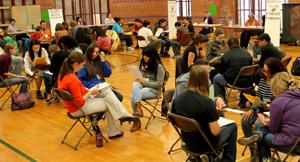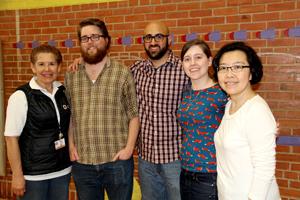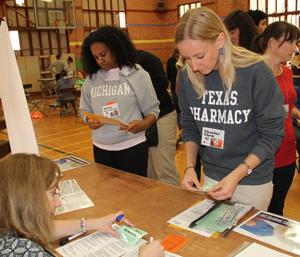
They gather early on a Saturday morning at the university’s Anna Hiss Gymnasium not exactly sure what to expect from the next couple of hours.

More than 80 people put aside their lives and preconceived thoughts and either took on the persona of one of the 45 million Americans who daily face significant financial challenges or assumed the role of a staff member working in a business or community service agency that works with indigent communities. For the next two hours they will gain a brief glimpse into what it means to walk this path.
Students and faculty from pharmacy, nursing, social work, communication, and dentistry had a chance to walk a mile in the shoes of some of their future patients and clients at the Poverty Simulation, an interprofessional education event designed to teach participants about disparities in living conditions within a community. Walking with these student participants were some staff members from community-based organizations and some young teens, creating a diverse, multi-generational participants group.
During the course of the exercise, participants were confronted with the realities of living with a small budget and limited time by role-playing as familial units challenged by a specific set of circumstances.
“I felt guilty role-playing what people struggle with in real life,” reflected participant and P2 student Haemy Chung. “However, after participating in the simulation, I feel like I better understand the struggles of lower income families that I will serve as a pharmacist. When there were bills threatening evacuation, healthcare became a luxury.”
As the simulation progressed, the families were challenged to collaborate among themselves and work with available institutions and resources to provide food, water, shelter and miscellaneous expenses for a one-month period, broken into four one-week units. A team of 20 volunteers represented agencies and organizations including public schools and work environments, utility and mortgage companies, pawn and quick loan agencies, grocery stores, as well as social service agencies.
“One of the most eye opening things for me was the intense level of stress I experienced in just a one hour simulation,” said Sara Rumbellow, another P2 participant. “Navigating a system I did not fully understand while feeling embarrassed and stressed about not being able to pay bills was very intimidating. This experience will greatly impact my future practice because I will think much more about the challenges my patients face on a daily basis and how those challenges might affect their health and ability to effectively use medications.”

The program, sponsored by the College of Pharmacy and Target, was organized by a pharmacy student team of Natalia Malesa, Brian Torabi and Alex Bishop under the direction of Dr. Veronica Young, director of the college’s interprofessional education. Dr. Adelita Cantu, of the UT Health Science Center School of Nursing, led the simulation.
“Through the planning/execution of the poverty simulation, I was asked ‘What does pharmacy have to do with poverty?’ During the simulation, my volunteer partner, a social work student, expressed surprise that pharmacy was hosting this event,” said pharmacy student organizer Natalia Malesa. “These reactions had a big impact on me. Community and ambulatory care pharmacists are on the front lines in providing care for patients living with disparity, yet we are among the last healthcare professionals that people think of in relation to issues of inequality.”
“I wish that every healthcare student could participate in a simulation like this in order to expand their world view,” said fellow student organizer Alex Bishop. “It (the simulation) goes beyond what can be taught in a classroom.”
“The simulation is an impactful tool that helps increase our empathy towards those we serve,” said Dr. Young. “I would love to see all health and social care professions students, including anyone who serves the community, participate in the poverty simulation. It helps participants set aside preconceived notions of what they think it means to live in poverty, and helps them to better appreciate the stress and daily struggles of those living with disparity.”

“Participation in this type of simulation can cause us to re-evaluate how we communicate and relate with our clients,” she continued. “It should make us question whether the care or services we provide are truly client-centered and community-oriented.”
She went on to say that pharmacy student participants learned that front-line pharmacists play an integral role in helping clients navigate the complex network of social services. They also learned that helping patients through this process is best achieved by taking the initiative to collaborate with other professions and community-based organizations.
At the start of the simulation, the room was filled with smiles and laughter as participants slipped into their roles and came to know other members of their family unit. The atmosphere quickly transitioned to somber and later stressful as time and resources slipped away and participants began to understand the unique challenges faced by those living below the federal poverty rate of $22,000 annually for a family of four.
“The Poverty Simulation provided realistic situations and created opportunities for all students to experience the stress, emotions, physical and financial distress that real people experience every day,” said Dr. Mary Mulvaney, clinical professor of social work who participated in the exercise. “Some stereotypes were debunked and the increased sensitivity to individuals and families in their environment will benefit all of our students. They (social work student participants) learned that they could assist their clients better by consulting with students from pharmacy and nursing, as they had knowledge and skills in different areas from the social work students.”
In Texas, where many of these participants will enter the workforce, living in poverty is a daily concern for 38 percent of single-parent families and for 16 percent of senior citizens. It is also estimated that more than one in four Texas children lack adequate access to food.
“Empathy is hard to acquire in a world where self-interest and self-preservation are often a priority,” said Brian Torabi, a P2 student and the third student coordinator, “The power of the Poverty Simulation is that you can trade three hours of your time for a lifetime of empathy towards a specific patient population.”

